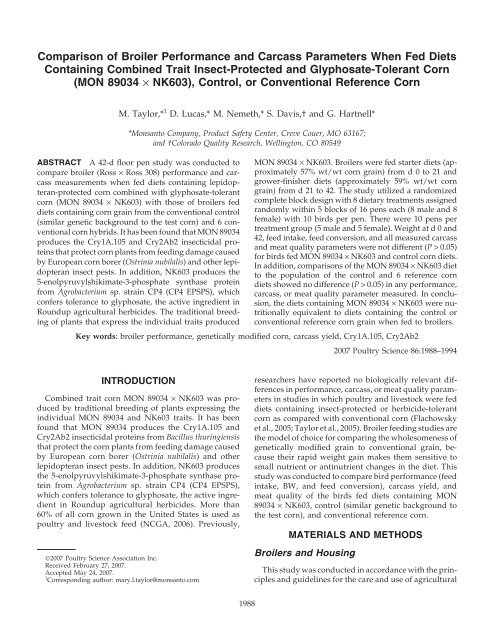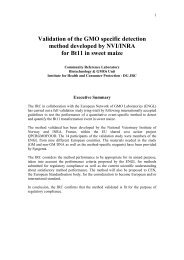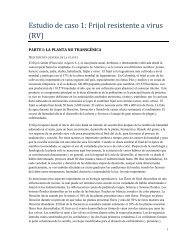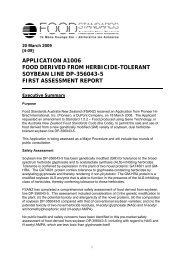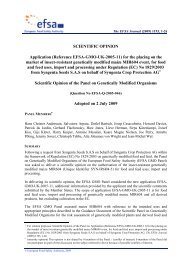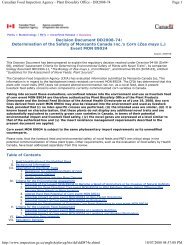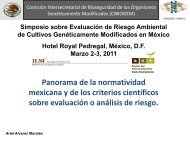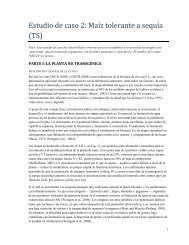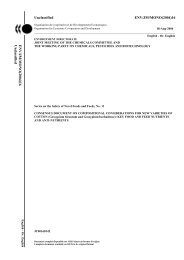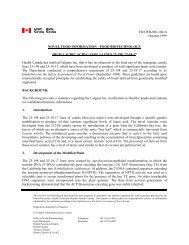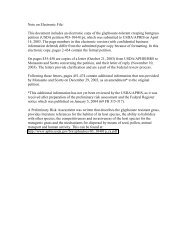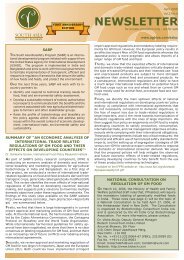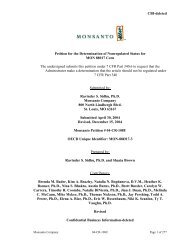Comparison of Broiler Performance and Carcass ... - CERA
Comparison of Broiler Performance and Carcass ... - CERA
Comparison of Broiler Performance and Carcass ... - CERA
You also want an ePaper? Increase the reach of your titles
YUMPU automatically turns print PDFs into web optimized ePapers that Google loves.
<strong>Comparison</strong> <strong>of</strong> <strong>Broiler</strong> <strong>Performance</strong> <strong>and</strong> <strong>Carcass</strong> Parameters When Fed Diets<br />
Containing Combined Trait Insect-Protected <strong>and</strong> Glyphosate-Tolerant Corn<br />
(MON 89034 × NK603), Control, or Conventional Reference Corn<br />
M. Taylor,* 1 D. Lucas,* M. Nemeth,* S. Davis,† <strong>and</strong> G. Hartnell*<br />
*Monsanto Company, Product Safety Center, Creve Couer, MO 63167;<br />
<strong>and</strong> †Colorado Quality Research, Wellington, CO 80549<br />
ABSTRACT A 42-d floor pen study was conducted to MON 89034 × NK603. <strong>Broiler</strong>s were fed starter diets (approximately<br />
compare broiler (Ross × Ross 308) performance <strong>and</strong> carcass<br />
measurements when fed diets containing lepidopteran-protected<br />
corn combined with glyphosate-tolerant<br />
corn (MON 89034 × NK603) with those <strong>of</strong> broilers fed<br />
57% wt/wt corn grain) from d 0 to 21 <strong>and</strong><br />
grower-finisher diets (approximately 59% wt/wt corn<br />
grain) from d 21 to 42. The study utilized a r<strong>and</strong>omized<br />
complete block design with 8 dietary treatments assigned<br />
diets containing corn grain from the conventional control r<strong>and</strong>omly within 5 blocks <strong>of</strong> 16 pens each (8 male <strong>and</strong> 8<br />
(similar genetic background to the test corn) <strong>and</strong> 6 conventional<br />
corn hybrids. It has been found that MON 89034<br />
female) with 10 birds per pen. There were 10 pens per<br />
treatment group (5 male <strong>and</strong> 5 female). Weight at d 0 <strong>and</strong><br />
42, feed intake, feed conversion, <strong>and</strong> all measured carcass<br />
produces the Cry1A.105 <strong>and</strong> Cry2Ab2 insecticidal proteins<br />
that protect corn plants from feeding damage caused<br />
<strong>and</strong> meat quality parameters were not different (P > 0.05)<br />
for birds fed MON 89034 × NK603 <strong>and</strong> control corn diets.<br />
by European corn borer (Ostrinia nubilalis) <strong>and</strong> other lepidopteran<br />
insect pests. In addition, NK603 produces the to the population <strong>of</strong> the control <strong>and</strong> 6 reference corn<br />
In addition, comparisons <strong>of</strong> the MON 89034 × NK603 diet<br />
5-enolpyruvylshikimate-3-phosphate synthase protein diets showed no difference (P > 0.05) in any performance,<br />
from Agrobacterium sp. strain CP4 (CP4 EPSPS), which carcass, or meat quality parameter measured. In conclusion,<br />
confers tolerance to glyphosate, the active ingredient in<br />
Roundup agricultural herbicides. The traditional breeding<br />
<strong>of</strong> plants that express the individual traits produced<br />
the diets containing MON 89034 × NK603 were nu-<br />
tritionally equivalent to diets containing the control or<br />
conventional reference corn grain when fed to broilers.<br />
Key words: broiler performance, genetically modified corn, carcass yield, Cry1A.105, Cry2Ab2<br />
2007 Poultry Science 86:1988–1994<br />
INTRODUCTION<br />
Combined trait corn MON 89034 × NK603 was produced<br />
by traditional breeding <strong>of</strong> plants expressing the<br />
individual MON 89034 <strong>and</strong> NK603 traits. It has been<br />
found that MON 89034 produces the Cry1A.105 <strong>and</strong><br />
Cry2Ab2 insecticidal proteins from Bacillus thuringiensis<br />
that protect the corn plants from feeding damage caused<br />
by European corn borer (Ostrinia nubilalis) <strong>and</strong> other<br />
lepidopteran insect pests. In addition, NK603 produces<br />
the 5-enolpyruvylshikimate-3-phosphate synthase protein<br />
from Agrobacterium sp. strain CP4 (CP4 EPSPS),<br />
which confers tolerance to glyphosate, the active ingredient<br />
in Roundup agricultural herbicides. More than<br />
60% <strong>of</strong> all corn grown in the United States is used as<br />
poultry <strong>and</strong> livestock feed (NCGA, 2006). Previously,<br />
©2007 Poultry Science Association Inc.<br />
Received February 27, 2007.<br />
Accepted May 24, 2007.<br />
1 Corresponding author: mary.l.taylor@monsanto.com<br />
researchers have reported no biologically relevant differences<br />
in performance, carcass, or meat quality parameters<br />
in studies in which poultry <strong>and</strong> livestock were fed<br />
diets containing insect-protected or herbicide-tolerant<br />
corn as compared with conventional corn (Flachowsky<br />
et al., 2005; Taylor et al., 2005). <strong>Broiler</strong> feeding studies are<br />
the model <strong>of</strong> choice for comparing the wholesomeness <strong>of</strong><br />
genetically modified grain to conventional grain, because<br />
their rapid weight gain makes them sensitive to<br />
small nutrient or antinutrient changes in the diet. This<br />
study was conducted to compare bird performance (feed<br />
intake, BW, <strong>and</strong> feed conversion), carcass yield, <strong>and</strong><br />
meat quality <strong>of</strong> the birds fed diets containing MON<br />
89034 × NK603, control (similar genetic background to<br />
the test corn), <strong>and</strong> conventional reference corn.<br />
MATERIALS AND METHODS<br />
<strong>Broiler</strong>s <strong>and</strong> Housing<br />
This study was conducted in accordance with the principles<br />
<strong>and</strong> guidelines for the care <strong>and</strong> use <strong>of</strong> agricultural<br />
1988
PERFORMANCE OF BROILERS FED GENETICALLY MODIFIED CORN 1989<br />
animals in research (Federation <strong>of</strong> Animal Science Societies,<br />
1999), was consistent with the recent recommendations<br />
issued by the International Life Sciences Institute<br />
(Cromwell et al., 2003), <strong>and</strong>, as applicable, was in compliance<br />
with FDA (1979) <strong>and</strong> EPA (1983) Good Laboratory<br />
Practice Regulations. Ross × Ross 308 broiler chickens<br />
were obtained (Welp’s Hatchery, Bancr<strong>of</strong>t, IA) at 1d<strong>of</strong><br />
age. <strong>Broiler</strong>s were vaccinated for Marek’s disease at the<br />
hatchery <strong>and</strong> for Newcastle disease <strong>and</strong> infectious bronchitis<br />
at the test site on the study start day. The broilers<br />
were r<strong>and</strong>omly assigned by sex to concrete floored pens<br />
(1.5 × 0.9 m, providing approximately 0.09 m 2 per bird<br />
excluding feeder space), with 10 to 13 cm <strong>of</strong> clean wood<br />
shavings in an environmentally controlled building with<br />
inc<strong>and</strong>escent lighting. Inc<strong>and</strong>escent lighting was provided<br />
for 23 to 24 h/d for approximately the first 4 d <strong>of</strong><br />
the study <strong>and</strong> for 10 to 16 h for the remainder <strong>of</strong> the<br />
study. The target room temperature was 34°C at the start<br />
<strong>of</strong> the study <strong>and</strong> was gradually decreased each day to<br />
a target room temperature <strong>of</strong> 23°C from d 30 through<br />
the remainder <strong>of</strong> the study. Water <strong>and</strong> feed were available<br />
for ad libitum consumption throughout the study.<br />
Within each pen, water was provided via 4 nipple drinkers,<br />
<strong>and</strong> feed was provided via a hanging tube feeder<br />
(43-cm diameter). A chick feeder tray was placed in each<br />
pen for the first 4 d. Environmental conditions (floor<br />
space, temperature, lighting, bird density, <strong>and</strong> feeder<br />
<strong>and</strong> water space) were similar for all treatments.<br />
Experimental Design<br />
A r<strong>and</strong>omized complete block design was used with<br />
8 dietary treatments (test, control, <strong>and</strong> 6 conventional<br />
reference corn diets). For each <strong>of</strong> the 8 treatment groups,<br />
there were 100 broilers in 10 pens (total <strong>of</strong> 800 broilers):<br />
5 pens <strong>of</strong> males <strong>and</strong> 5 pens <strong>of</strong> females (10 broilers/pen).<br />
Initially, there were an additional 2 broilers in each pen<br />
to compensate for early chick mortality during the first<br />
few days posthatch. At d 7, the group size was adjusted<br />
to 10 broilers/pen. The initial criterion for d-7 bird removal<br />
was unthrifty birds with a health or deformity<br />
problem (leg problem, crooked beak, swollen eyes) that<br />
would prevent the bird from surviving the length <strong>of</strong> the<br />
study, followed by r<strong>and</strong>om selection, the reason for the<br />
majority <strong>of</strong> removals.<br />
Corn Grain<br />
The control corn grain <strong>and</strong> MON 89034 × NK603 were<br />
produced in Madison County, Illinois, during the 2005<br />
growing season. Conventional reference corn grain (NC<br />
+ 5411, NK N72-J5, Midl<strong>and</strong> 7B15, Garst 8371, <strong>and</strong> Pioneer<br />
32B33) was produced in 2005 in Warren County,<br />
Illinois, <strong>and</strong> conventional reference DKC61-50 was produced<br />
in 2005 in York County, Nebraska.<br />
Mycotoxin (Romer Laboratories, Union, MO; aflatoxins,<br />
ochratoxin, citrinin, zearalenone, trichothecenes,<br />
<strong>and</strong> fumonisins) <strong>and</strong> pesticide residue (FDA, 1999; Covance<br />
Laboratories, Madison, WI; organochlorinates, organophosphates,<br />
organonitrogens, <strong>and</strong> N-methylcarbamates)<br />
analyses <strong>of</strong> the corn grain were conducted to<br />
verify that the levels were below the limits <strong>of</strong> concern for<br />
broiler performance. Proximate [CP (955.04 <strong>and</strong> 979.09),<br />
crude fat (960.39 <strong>and</strong> 948.22), crude fiber (962.09), <strong>and</strong><br />
moisture (926.08 <strong>and</strong> 925.09)] <strong>and</strong> amino acid (982.30)<br />
analyses were performed on the grain at Covance Laboratories<br />
according to methods <strong>of</strong> AOAC International<br />
(2005). Carbohydrate values were calculated.<br />
Diets<br />
Diets were formulated to contain approximately the<br />
same amount <strong>of</strong> corn <strong>and</strong> equivalent ME, amino acid<br />
(Lys, Met + Cys, Trp, Thr, <strong>and</strong> Arg), CP, Ca, P, N, <strong>and</strong><br />
K specifications based on the individual nutrient analyses<br />
<strong>of</strong> each grain lot (Table 1). Dietary protein was provided<br />
by the corn grain supplemented with commercial<br />
dehulled soybean meal. Diets were formulated to meet<br />
or exceed NRC (1994) values for poultry. A coccidiostat,<br />
salinomycin (Intervet Inc., Millsboro, DE), was included<br />
in all diets at a level <strong>of</strong> 50 g/ton. <strong>Broiler</strong>s were fed a<br />
starter diet containing approximately 57% wt/wt corn<br />
grain from d 0 to 21. For the rest <strong>of</strong> the experiment<br />
(d 21 to 42), broilers were fed a grower-finisher diet<br />
containing approximately 59% wt/wt corn grain (Table<br />
2). Proximate [CP (990.03), crude fat (954.02), <strong>and</strong> moisture<br />
(934.01)], amino acid (982.30), <strong>and</strong> mineral (985.01)<br />
analyses <strong>of</strong> poultry diets (University <strong>of</strong> Missouri, Experiment<br />
Station Chemical Laboratories, Columbia, MO)<br />
were conducted according to AOAC International methods<br />
for confirmation <strong>of</strong> formulated levels <strong>of</strong> nutrient<br />
composition.<br />
Measurements<br />
<strong>Broiler</strong>s were observed regularly for general health.<br />
All dead birds <strong>and</strong> those killed due to their unhealthy<br />
condition were weighed <strong>and</strong> necropsied, <strong>and</strong> the probable<br />
cause <strong>of</strong> death or reason for removal was documented.<br />
<strong>Broiler</strong>s were weighed at d 0 <strong>and</strong> 42 by pen<br />
<strong>and</strong> individually before processing at study termination<br />
(d 43 for males <strong>and</strong> d 44 for females). Average BW (kg)<br />
<strong>and</strong> feed intake (kg) were calculated from pen data. The<br />
average feed conversion (kg/kg) per pen was calculated<br />
for the entire duration <strong>of</strong> the study by dividing the total<br />
feed consumption during the study by the total BW <strong>of</strong><br />
the surviving broilers in the pen. Adjusted feed conversion<br />
was calculated by dividing the total feed consumption<br />
per pen by the total BW <strong>of</strong> the surviving broilers<br />
<strong>and</strong> those that died or were removed from the pen. At<br />
the end <strong>of</strong> the study, all broilers were processed for<br />
assessment <strong>of</strong> carcass yield. Skinless thigh <strong>and</strong> breast<br />
tissues were collected from 1 r<strong>and</strong>omly selected broiler<br />
from each pen <strong>and</strong> analyzed for moisture (934.01), protein<br />
(984.13), <strong>and</strong> fat (954.02) at the Experiment Station<br />
Chemical Laboratories according to the 17th edition <strong>of</strong><br />
the AOAC International methods (AOAC, 2000).
1990<br />
TAYLOR ET AL.<br />
Table 1. Proximate (%) <strong>and</strong> amino acid (%) composition 1 <strong>of</strong> MON 89034 × NK603, control, <strong>and</strong> conventional reference corn<br />
Analyzed composition MON H1325023 DKC61-50 NC + 5411 NK N72-J5 Midl<strong>and</strong> 7B15 Garst 8371 Pioneer 32B33<br />
(as-is basis) 89034 × NK603 control reference reference reference reference reference reference<br />
CP 7.89 7.59 8.84 7.35 6.84 7.07 6.91 7.24<br />
Crude fat 2.39 2.51 3.37 2.38 2.41 2.33 2.24 3.13<br />
Moisture 10.8 10.9 11.3 11.1 12.5 11.3 12.1 12.4<br />
Crude fiber 2.87 2.66 2.33 2.68 3.18 3.28 2.90 2.33<br />
Asp 0.53 0.54 0.62 0.48 0.48 0.46 0.47 0.51<br />
Thr 0.29 0.29 0.33 0.27 0.26 0.26 0.26 0.27<br />
Ser 0.38 0.39 0.48 0.37 0.36 0.35 0.36 0.38<br />
Glx 1.32 1.44 1.84 1.33 1.25 1.25 1.28 1.41<br />
Pro 0.63 0.66 0.83 0.69 0.67 0.65 0.66 0.67<br />
Gly 0.33 0.33 0.34 0.29 0.30 0.29 0.29 0.29<br />
Ala 0.55 0.58 0.73 0.52 0.51 0.49 0.50 0.56<br />
Cys 0.17 0.18 0.19 0.18 0.16 0.18 0.17 0.15<br />
Val 0.37 0.39 0.45 0.35 0.35 0.33 0.34 0.35<br />
Met 0.18 0.20 0.17 0.16 0.15 0.16 0.15 0.15<br />
Ile 0.26 0.28 0.34 0.25 0.24 0.23 0.24 0.25<br />
Leu 0.85 0.93 1.26 0.87 0.81 0.80 0.83 0.93<br />
Tyr 0.27 0.19 0.21 0.26 0.24 0.23 0.24 0.25<br />
Phe 0.38 0.40 0.51 0.38 0.36 0.36 0.37 0.39<br />
His 0.22 0.23 0.25 0.22 0.21 0.21 0.21 0.21<br />
Lys 0.28 0.28 0.28 0.23 0.24 0.23 0.22 0.22<br />
Arg 0.40 0.37 0.39 0.34 0.35 0.34 0.33 0.35<br />
Trp 0.05 0.05 0.05 0.05 0.04 0.04 0.04 0.04<br />
1 Analyses conducted at Covance Laboratories, Madison, Wisconsin.<br />
Statistical Analysis<br />
Statistical analyses were performed on d 0, d 42, preprocessing<br />
live weights, feed consumption, feed conversion,<br />
adjusted feed conversion, chilled carcass weight,<br />
fad pad, breast, thigh, wing, <strong>and</strong> drum weight; as well<br />
as moisture, protein, <strong>and</strong> fat values for breast <strong>and</strong> thigh<br />
meat. <strong>Carcass</strong> yield values were evaluated on a weight<br />
basis <strong>and</strong> as a percentage <strong>of</strong> preprocessing live or chilled<br />
carcass weight as appropriate. Statistical analysis (AN-<br />
OVA) was carried out using a linear mixed model procedure<br />
<strong>of</strong> SAS, version 9.1.3 (SAS Institute Inc., Cary, NC).<br />
The statistical model included effects <strong>of</strong> treatments,<br />
sex, block, <strong>and</strong> sex × treatment interactions, with the<br />
Table 2. Ingredient composition <strong>of</strong> diets containing MON 89034 × NK603, control, <strong>and</strong> conventional reference corn<br />
Ingredient MON H1325023 DKC61-50 NC + 5411 NK N72-J5 Midl<strong>and</strong> 7B15 Garst 8371 Pioneer 32B33<br />
(%, as-is basis) 89034 × NK603 control reference reference reference reference reference reference<br />
Starter diet formulation<br />
Corn 57.34 57.51 58.09 56.89 56.59 56.40 56.55 56.78<br />
Dehulled soybean meal 35.80 35.65 35.15 36.15 36.40 36.60 36.45 36.25<br />
Soy oil 3.35 3.35 3.25 3.45 3.50 3.50 3.50 3.45<br />
Defluorinated phosphate 1.80 1.85 1.80 1.90 1.90 1.85 1.90 1.90<br />
Limestone 0.80 0.75 0.80 0.70 0.70 0.75 0.70 0.70<br />
Salt 0.30 0.29 0.29 0.29 0.28 0.29 0.28 0.28<br />
DL-Met 0.23 0.21 0.23 0.23 0.24 0.22 0.23 0.24<br />
Choline chloride 60% 0.15 0.15 0.15 0.15 0.15 0.15 0.15 0.15<br />
Trace minerals 1 0.10 0.10 0.10 0.10 0.10 0.10 0.10 0.10<br />
Vitamins 2 0.10 0.10 0.10 0.10 0.10 0.10 0.10 0.10<br />
Sacox (coccidiostat) 0.04 0.04 0.04 0.04 0.04 0.04 0.04 0.04<br />
Grower-finisher diet formulation<br />
Corn 59.43 59.50 59.44 59.44 59.43 59.48 59.43 59.48<br />
Dehulled soybean meal 33.50 33.5 33.50 33.50 33.50 33.5 33.50 33.50<br />
Soy oil 3.80 3.80 3.80 3.85 3.85 3.80 3.85 3.80<br />
Defluorinated phosphate 1.70 1.70 1.70 1.75 1.75 1.70 1.75 1.75<br />
Limestone 0.70 0.65 0.70 0.60 0.60 0.65 0.60 0.60<br />
Salt 0.31 0.31 0.31 0.30 0.30 0.31 0.30 0.30<br />
DL-Met 0.22 0.20 0.21 0.22 0.23 0.22 0.23 0.23<br />
Choline chloride 60% 0.10 0.10 0.10 0.10 0.10 0.10 0.10 0.10<br />
Trace minerals 1 0.10 0.10 0.10 0.10 0.10 0.10 0.10 0.10<br />
Vitamins 2 0.10 0.10 0.10 0.10 0.10 0.10 0.10 0.10<br />
Sacox (coccidiostat) 0.04 0.04 0.04 0.04 0.04 0.04 0.04 0.04<br />
1 Trace mineral premix (SEM Minerals, Quincy, IL) contained 5 to 6% Ca <strong>and</strong> provided the following in milligrams per kilogram <strong>of</strong> diet: Mn,<br />
120; Zn, 100; Fe, 40; Cu, 10; I, 1.4; Se, 0.3, <strong>and</strong> Mg, 26.<br />
2 Vitamin premix (Roche Vitamins Inc., Parsippany, NJ) provided the following per kilogram <strong>of</strong> diet: vitamin A, 9,350 IU from all trans-retinyl<br />
acetate; cholecalciferol D 3 , 3,025 IU; vitamin E, 27.5 IU from DL-α-tocopherol; vitamin B 12 , 13.75 mg; rib<strong>of</strong>lavin, 7.7 mg; niacin, 49.5 mg; pantothenic<br />
acid, 12.1 mg; menadione, 1.925 mg; folic acid, 0.99 mg; ethoxyquin, 77 mg; biotin, 0.088 mg; thiamine, 1.925 mg; <strong>and</strong> pyridoxine, 3.08 mg.
PERFORMANCE OF BROILERS FED GENETICALLY MODIFIED CORN 1991<br />
Table 3. Nutrient composition <strong>of</strong> diets containing MON 89034 × NK603, control, <strong>and</strong> conventional reference corn<br />
Analyzed composition MON H1325023 DKC61-50 NC + 5411 NK N72-J5 Midl<strong>and</strong> 7B15 Garst 8371 Pioneer 32B33<br />
(as-is basis) 89034 × NK603 control reference reference reference reference reference reference<br />
Starter diets<br />
ME 1 (kcal/kg) 3,079 3,080 3,081 3,081 3,081 3,078 3,080 3,080<br />
CP (%) 21.8 22.2 22.4 22.8 20.6 22.6 21.9 22.6<br />
Crude fat (%) 5.33 5.32 4.80 4.89 5.48 5.13 5.36 5.43<br />
Moisture (%) 12.0 11.5 13.5 12.6 12.5 12.5 12.6 12.5<br />
Arg (%) 1.47 1.47 1.40 1.49 1.35 1.47 1.44 1.50<br />
Lys (%) 1.29 1.31 1.23 1.34 1.20 1.31 1.27 1.32<br />
Met (%) 0.56 0.52 0.50 0.49 0.49 0.50 0.49 0.54<br />
Cys (%) 0.37 0.37 0.37 0.38 0.35 0.38 0.37 0.37<br />
Trp (%) 0.27 0.26 0.24 0.28 0.24 0.27 0.27 0.28<br />
Thr (%) 0.83 0.83 0.83 0.84 0.78 0.85 0.83 0.86<br />
Val (%) 1.02 1.02 0.99 1.07 0.95 0.98 0.97 1.01<br />
Ca (%) 1.02 0.98 0.84 0.76 0.83 0.85 0.79 0.81<br />
P (%) 0.78 0.77 0.67 0.64 0.66 0.67 0.65 0.66<br />
Grower-finisher diets<br />
ME 1 (kcal/kg) 3,133 3,134 3,133 3,137 3,137 3,135 3,137 3,135<br />
CP (%) 21.3 21.7 22.3 21.0 20.7 20.6 20.9 21.6<br />
Crude fat (%) 6.09 5.87 5.84 5.36 5.96 5.69 5.67 6.41<br />
Moisture (%) 11.1 11.1 12.2 12.0 11.1 11.9 11.9 11.2<br />
Arg (%) 1.41 1.43 1.42 1.40 1.36 1.34 1.35 1.43<br />
Lys (%) 1.25 1.27 1.24 1.24 1.18 1.19 1.19 1.25<br />
Met (%) 0.55 0.52 0.52 0.53 0.54 0.51 0.50 0.56<br />
Cys (%) 0.35 0.36 0.36 0.36 0.35 0.34 0.35 0.35<br />
Trp (%) 0.26 0.27 0.26 0.24 0.24 0.24 0.24 0.26<br />
Thr (%) 0.81 0.81 0.82 0.80 0.79 0.77 0.77 0.80<br />
Val (%) 0.97 1.03 1.04 1.00 0.90 0.95 0.98 1.01<br />
Ca (%) 0.97 0.85 0.92 0.88 0.87 0.86 0.85 0.93<br />
P (%) 0.79 0.70 0.74 0.69 0.68 0.69 0.67 0.73<br />
1 Calculated based on assigned values for diet components.<br />
experimental unit being the pen. The mean values obtained<br />
for the broilers fed MON 89034 × NK603 diets<br />
were compared (combined sex) with those fed the control<br />
<strong>and</strong> conventional reference corn diets at the 5% level<br />
<strong>of</strong> significance using a protected Fisher’s least significant<br />
difference test (Fisher, 1949). When a significant sex ×<br />
treatment interaction was noted (P < 0.15), the mean<br />
values were also evaluated by sex. An additional statistical<br />
analysis compared data from broilers fed the MON<br />
89034 × NK603 diet to the population <strong>of</strong> responses from<br />
broilers fed the control <strong>and</strong> conventional reference corn<br />
diets to determine whether the values <strong>of</strong> the test corn<br />
diet were within the population <strong>of</strong> control <strong>and</strong> reference<br />
corn diets used in this study.<br />
RESULTS<br />
General Observations<br />
Mycotoxin <strong>and</strong> pesticide levels in MON 89034 ×<br />
NK603, control, <strong>and</strong> conventional reference corn used<br />
in diet preparation were below the limits <strong>of</strong> concern for<br />
broiler performance. All pesticide values were below<br />
the assay limits <strong>of</strong> detection reported in parentheses<br />
<strong>and</strong> were as follows: organophosphates (0.050 ppm),<br />
organonitrogens (0.500 ppm), organochlorinates (0.200<br />
ppm), <strong>and</strong> N-methylcarbamates (0.100 ppm). The nutrient<br />
assay results for diets are presented in Table 3.<br />
Chick mortality was low (0.2%) during the first 7 d,<br />
<strong>and</strong> mortality observed was primarily due to bacterial<br />
infection, dehydration, or starve-out. Mortality from d<br />
7 to 42 ranged from 1 to 2% across treatments (mortality<br />
for the MON 89034 × NK603 treatment was 1%). The d<br />
7 to 42 deaths were primarily attributed to sudden death<br />
<strong>and</strong> ascites. Mortality was r<strong>and</strong>om across treatments,<br />
<strong>and</strong> remaining broilers in all treatments were in good<br />
health.<br />
<strong>Performance</strong> measurements <strong>of</strong> BW at d 0 (g/bird <strong>and</strong><br />
kg/pen) <strong>and</strong> d 42 (kg/bird <strong>and</strong> kg/pen), total feed intake<br />
(kg/bird <strong>and</strong> kg/pen), <strong>and</strong> unadjusted <strong>and</strong> adjusted<br />
feed conversion (kg/kg) were not different (P ><br />
0.05) between the broilers fed diets containing MON<br />
89034 × NK603 <strong>and</strong> those fed control corn with similar<br />
genetic background (Table 4). Likewise, carcass measurements<br />
including chilled weight <strong>and</strong> fat pad weight<br />
(kg <strong>and</strong> % <strong>of</strong> live weight) <strong>and</strong> weights <strong>of</strong> breast, wing,<br />
drum, <strong>and</strong> thigh parts (each expressed as kg <strong>and</strong> % <strong>of</strong><br />
chilled weight) were not different (P > 0.05) between<br />
broilers fed diets containing MON 89034 × NK603 <strong>and</strong><br />
those fed the control corn diet. A significant (P < 0.05)<br />
difference was detected for fat pad weights (kg <strong>and</strong> %<br />
<strong>of</strong> chilled weight); however, fat pad weights for broilers<br />
fed both MON 89034 × NK603 <strong>and</strong> control corn grain<br />
diets were not different <strong>and</strong> were within the range <strong>of</strong><br />
weights observed among the 6 conventional reference<br />
corn based diets (Table 4). No differences (P > 0.05)<br />
among any <strong>of</strong> the diets were observed for the percentage<br />
<strong>of</strong> moisture, protein, or fat in skinless thigh <strong>and</strong> breast<br />
meat samples collected at processing. <strong>Comparison</strong> <strong>of</strong> the<br />
data from broilers fed MON 89034 × NK603 corn to that
1992<br />
TAYLOR ET AL.<br />
Table 4. <strong>Performance</strong>, carcass yield, <strong>and</strong> meat quality comparison <strong>of</strong> broilers fed diets containing MON 89034 × NK603, control, <strong>and</strong> conventional reference corn 1<br />
MON NC Midl<strong>and</strong> Garst Pioneer<br />
89034 H1325023 DKC61-50 + 5411 NK N72-J5 7B15 8371 32B33 Treatment LSD 2<br />
Item × NK603 control reference reference reference reference reference reference P 5.0%<br />
<strong>Performance</strong><br />
Live weight (g/bird), d 0 38.183 38.850 38.517 39.017 38.850 38.767 38.433 38.400 NS 0.758<br />
Live weight (kg/bird), d 42 2.682 2.649 2.614 2.685 2.650 2.647 2.654 2.623 NS 0.064<br />
Feed intake (kg/bird) 4.260 4.217 4.149 4.275 4.195 4.205 4.236 4.166 NS 0.100<br />
Feed intake (kg/pen) 42.205 41.745 41.195 42.745 41.715 41.405 41.945 41.390 NS 1.431<br />
Feed conversion (kg/kg) 1.632 1.636 1.637 1.619 1.639 1.644 1.641 1.638 NS 0.049<br />
Adjusted feed 1.609 1.612 1.601 1.609 1.603 1.612 1.614 1.605 NS 0.022<br />
conversion 3 (kg/kg)<br />
<strong>Carcass</strong> yield<br />
Processing live weight 4 (kg) 2.642 2.602 2.575 2.632 2.609 2.599 2.608 2.583 NS 0.061<br />
Chilled weight (kg) 1.888 1.857 1.832 1.886 1.861 1.860 1.864 1.843 NS 0.046<br />
Chilled weight 71.468 71.400 71.204 71.656 71.376 71.570 71.501 71.345 NS 0.392<br />
(% <strong>of</strong> live weight)<br />
Fat pad weight (kg) 0.047 ab 0.045 abc 0.042 c 0.045 abc 0.047 ab 0.045 bc 0.049 a 0.044 bc * 0.004<br />
Fat pad weight 1.803 ab 1.766 abc 1.647 c 1.740 bc 1.810 ab 1.751 bc 1.894 a 1.711 bc * 0.137<br />
(% <strong>of</strong> live weight)<br />
Breast meat weight (kg) 0.514 0.502 0.498 0.509 0.500 0.502 0.503 0.497 NS 0.017<br />
Breast meat weight 27.159 27.011 27.209 26.969 26.879 26.969 26.993 26.969 NS 0.461<br />
(% <strong>of</strong> chill weight)<br />
Thigh weight (kg) 0.335 0.327 0.325 0.336 0.333 0.331 0.329 0.322 NS 0.010<br />
Thigh weight 17.745 17.591 17.720 17.783 17.851 17.784 17.672 17.451 NS 0.320<br />
(% <strong>of</strong> chill weight)<br />
Drum weight (kg) 0.266 0.263 0.261 0.268 0.263 0.262 0.265 0.260 NS 0.006<br />
Drum weight 14.102 14.174 14.200 14.177 14.133 14.090 14.191 14.099 NS 0.200<br />
(% <strong>of</strong> chill weight)<br />
Wing weight (kg) 0.208 0.203 0.202 0.205 0.204 0.205 0.205 0.202 NS 0.004<br />
Wing weight 11.027 10.930 11.000 10.864 10.937 11.036 11.024 10.997 NS 0.178<br />
(% <strong>of</strong> chill weight)<br />
Breast meat analysis<br />
Moisture (%) 75.445 75.481 75.251 75.399 75.390 75.337 75.197 75.416 NS 0.414<br />
Protein (%, as-is basis) 22.148 22.253 22.518 22.310 22.302 22.452 22.557 22.271 NS 0.494<br />
Fat (%, as-is basis) 0.779 0.791 0.760 0.745 0.732 0.637 0.698 0.712 NS 0.197<br />
Thigh meat analysis<br />
Moisture (%) 76.744 76.498 76.572 76.594 76.847 76.717 76.524 76.889 NS 0.505<br />
Protein (%, as-is basis) 20.242 20.227 20.464 20.285 19.898 20.758 20.493 19.910 NS 0.697<br />
Fat (%, as-is basis) 1.512 1.639 1.765 1.674 1.470 1.422 1.926 1.547 NS 0.527<br />
a–c Individual treatment means (sample size <strong>of</strong> 10) with the same superscript letter in the same row are not statistically different (P < 0.05); NS = P < 0.05.<br />
1 Mean values <strong>of</strong> combined males <strong>and</strong> females.<br />
2 LSD = least significant difference between 2 means (P < 0.05).<br />
3 Feed conversion adjusted by dividing the total feed consumption per pen by the total BW <strong>of</strong> the surviving broilers <strong>and</strong> those that died or were removed from the pen.<br />
4 Processing live weight = preprocessing weight on d 43 (males) or d 44 (females).<br />
*P < 0.05.
PERFORMANCE OF BROILERS FED GENETICALLY MODIFIED CORN 1993<br />
Table 5. <strong>Performance</strong>, carcass yield, <strong>and</strong> meat quality comparison <strong>of</strong> MON 89034 × NK603 with population <strong>of</strong><br />
control <strong>and</strong> conventional corn references 1 Corn in diets Variety effect<br />
MON<br />
Control <strong>and</strong><br />
89034 conventional LSD 3<br />
Parameter × NK603 references SSD 2 5%<br />
<strong>Performance</strong><br />
Live weight (g/bird), d 0 38.183 38.690 NS 0.655<br />
Live weight (kg/bird), d 42 2.682 2.646 NS 0.053<br />
Feed intake (kg/bird) 4.260 4.206 NS 0.110<br />
Feed conversion (kg/kg) 1.632 1.636 NS 0.037<br />
Adjusted feed conversion (kg/kg) 1.609 1.608 NS 0.016<br />
<strong>Carcass</strong> yield<br />
Processing live weight (kg/bird) 2.642 2.601 NS 0.045<br />
Chill weight (kg/bird) 1.888 1.858 NS 0.044<br />
Chill weight (% <strong>of</strong> live weight) 71.468 71.436 NS 0.396<br />
Fat pad weight (kg/bird) 0.047 0.045 NS 0.006<br />
Fat pad weight (% <strong>of</strong> live weight) 1.803 1.760 NS 0.203<br />
Breast weight (% <strong>of</strong> chill weight) 27.159 27.000 NS 0.339<br />
Thigh weight (% <strong>of</strong> chill weight) 17.745 17.693 NS 0.356<br />
Drum weight (% <strong>of</strong> chill weight) 14.102 14.152 NS 0.142<br />
Wing weight (% <strong>of</strong> chill weight) 11.027 10.970 NS 0.133<br />
Breast meat analysis<br />
Moisture (%) 75.445 75.353 NS 0.297<br />
Protein (%, as-is basis) 22.148 23.380 NS 0.358<br />
Fat (%, as-is basis) 0.779 0.725 NS 0.148<br />
Thigh meat analysis<br />
Moisture (%) 76.744 76.663 NS 0.377<br />
Protein (%, as-is basis) 20.242 20.291 NS 0.822<br />
Fat (%, as-is basis) 1.512 1.635 NS 0.467<br />
1 Mean values <strong>of</strong> combined males <strong>and</strong> females.<br />
2 SSD = statistical significance <strong>of</strong> differences; NS = P > 0.05.<br />
3 LSD = least significant difference between 2 means (P < 0.05).<br />
<strong>of</strong> the population <strong>of</strong> broilers (combined sex) fed diets<br />
containing control <strong>and</strong> conventional reference corn<br />
showed no differences (P > 0.05) in any measured performance,<br />
carcass yield, or meat quality parameter (Table<br />
5).<br />
DISCUSSION<br />
The results <strong>of</strong> this broiler feeding study support the<br />
conclusion that there are no differences in the parameters<br />
evaluated between broilers fed insect-protected <strong>and</strong><br />
glyphosate-tolerant (MON 89034 × NK603), genetically<br />
similar control, <strong>and</strong> conventional reference corn. The<br />
MON 89034 × NK603 corn evaluated in this study is<br />
nutritionally equivalent in broiler diets to grain from<br />
the control <strong>and</strong> conventional references. This conclusion<br />
is consistent with the compositional evaluation <strong>of</strong> the<br />
MON 89034 × NK603 corn that showed no relevant differences<br />
in nutritional <strong>and</strong> compositional properties relative<br />
to control <strong>and</strong> conventional corn (Taylor et al.,<br />
2007). Flachowsky et al. (2005) reviewed published reports<br />
<strong>of</strong> feeding studies evaluating genetically modified<br />
grain <strong>and</strong> found no reports <strong>of</strong> significant effects <strong>of</strong> feeding<br />
broilers with grain containing either insect-protected<br />
or herbicide-tolerant traits on broiler performance or<br />
carcass parameters. Furthermore, Taylor et al. (2007) reported<br />
no meaningful difference in broiler performance<br />
or carcass parameters when fed diets containing MON<br />
89034 single-trait or MON 89034 × MON 810 combinedtrait<br />
corn grain compared with those <strong>of</strong> birds fed identically<br />
formulated control <strong>and</strong> conventional reference<br />
corn-based diets. These data support the conclusion that<br />
the grain from MON 89034 × NK603 corn is as nutritious<br />
as conventional corn.<br />
REFERENCES<br />
AOAC. 2000. Official Methods <strong>of</strong> Analysis <strong>of</strong> AOAC International.<br />
17th ed. AOAC Int., Gaithersburg, MD.<br />
AOAC International. 2005. Official Methods <strong>of</strong> Analysis <strong>of</strong><br />
AOAC International. 18th ed. AOAC Int., Gaithersburg,<br />
MD.<br />
Cromwell, G., G. Dana, <strong>and</strong> G. Hartnell. 2003. Pages 1–62 in<br />
Best Practices for the Conduct <strong>of</strong> Animal Studies to Evaluate<br />
Crops Genetically Modified for Input Traits. Int. Life Sci.<br />
Inst., Washington, DC.<br />
EPA. 1983. 40 CFR Part 160. Federal Insecticide, Fungicide<br />
<strong>and</strong> Rodenticide Act (FIFRA): Good Laboratory Practice<br />
St<strong>and</strong>ards. Environ. Prot. Agency, Washington, DC.<br />
FDA. 1979. Department <strong>of</strong> Health <strong>and</strong> Human Services. 21<br />
CFR Part 58. Good Laboratory Practice Regulations for Nonclincal<br />
Laboratory Studies. Food Drug Adm., Washington,<br />
DC.<br />
FDA. 1999. Multiclass Multiresidue Methods: 304 Method for<br />
Fatty Foods. Pages 304-1–304-33 in Pesticide Analytical<br />
Manual Volume 1: Multiresidue Methods. 3rd ed. Food<br />
Drug Adm., Washington, DC.
1994<br />
TAYLOR ET AL.<br />
Federation <strong>of</strong> Animal Science Societies. 1999. Guidelines for<br />
the Care <strong>and</strong> Use <strong>of</strong> Agricultural Animals in Research <strong>and</strong><br />
Teaching. 1st rev. Fed. Anim. Sci. Soc., Savoy, IL.<br />
Fisher, R. A. 1949. The Design <strong>of</strong> Experiments. Oliver Boyd,<br />
Edinburgh, UK.<br />
Flachowsky, G. A., A. Chesson, <strong>and</strong> K. Aulrich. 2005. Animal<br />
nutrition with feeds from genetically modified plants. Arch.<br />
Anim. Nutr. 59:1–40.<br />
NCGA. 2006. Glossory <strong>of</strong> corn terms. http://www.ncga.com/<br />
education/main/glossary.html Accessed Jan. 5, 2007.<br />
NRC. 1994. Nutritional Requirements <strong>of</strong> Poultry. 9th ed. Natl.<br />
Acad. Sci., Washington, DC.<br />
Taylor, M. L., G. Hartnell, M. Nemeth, K. Karunan<strong>and</strong>aa, <strong>and</strong><br />
B. George. 2005. <strong>Comparison</strong> <strong>of</strong> broiler performance when<br />
fed diets containing corn grain with insect-protected (corn<br />
rootworm <strong>and</strong> European corn borer) <strong>and</strong> herbicide-tolerant<br />
(glyphosate) traits, control corn, or commercial reference<br />
corn-revisited. Poult. Sci. 84:1893–1899.<br />
Taylor, M. L., D. Lucas, M. Nemeth, S. Davis, <strong>and</strong> G. Hartnell.<br />
2007. <strong>Comparison</strong> <strong>of</strong> broiler performance when fed diets<br />
containing grain from second generation insect-protected<br />
<strong>and</strong> glyphosate-tolerant, conventional control or commercial<br />
reference corn. Poult. Sci. 86:1972–1979.


